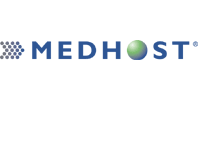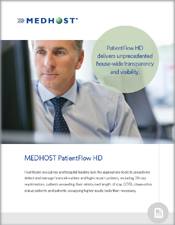Resource:
MEDHOST PatientFlow HD Product Details
Learn how PatientFlow HD delivers unprecedented house-wide transparency and visibility.
Health care executives and hospital leaders lack the appropriate tools to proactively detect and manage financial outliers and high-impact patients, including 30-day readmissions, patients exceeding their reimbursed length of stay (LOS), observation status patients and patients occupying higher acuity beds than necessary.
Patient-flow issues erode your bottom line, and if not managed effectively, can result in serious penalties, which is why MEDHOST developed PatientFlow HD. This powerful yet easy-to-use, Web-based patient throughput solution delivers tangible business and financial improvements by providing executives and hospital leaders with mission-critical facility, clinical and patient-centric data so they can identify process management and patient-flow issues before they become problems. Providers can also leverage PatientFlow HD to comply with The Joint Commission’s patient-flow requirements.
PatientFlow HD’s robust analytics and reporting tools provide a real-time and historically trended, enterprise-wide view, making it possible for leaders to easily manage day-to-day operations and the wide assortment of factors and influences that affect patient flow. PatientFlow HD gives insight into staff variance, payer mix classification with associated Case Mix Index detail, actual vs. budgeted key performance indicators, and more, via an intuitive, display-rich format.
Additionally, PatientFlow HD offers visibility at the unit and bedside levels. With onscreen and push notifications, everyone involved in patient care stays informed. This creates a culture of accountability and helps improve patient care and safety, the objective of The Joint Commission’s patient-flow requirements. PatientFlow HD also breaks down information silos, a major contributor to patient-flow bottlenecks, because a vast amount of real-time information — such as anticipated discharges, admission requests, housekeeping status, current patient locations and ED admission needs — is available to all hospital departments at all times.

